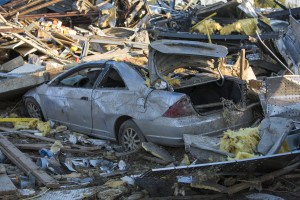About 40 scientists from around the nation are expected to participate in “VORTEX Southeast,” an upcoming study of the unique characteristics of tornadoes that develop in the South, weather researchers say.
Like earlier studies in the Midwest, the research based in Huntsville, Alabama, will include mobile radars, drones and other equipment that can measure tornado intensity. It is set to run through March and April.
VORTEX, an acronym for Verification of the Origins of Rotation in Tornadoes Experiment, began in the mid-1990s with a large tornado study that helped inspired the Hollywood film “Twister.”
Another large study, VORTEX 2, took place from 2009-2010.
This spring, researchers hope to learn more about the mysteries of Southern tornadoes, such as whether the landscape in the South gives them added power, and how to warn people at night, when many tornadoes strike in the South.
The research aims to find ways of better forecasting tornadoes, communicating warnings more effectively and finding out how the public responds to those warnings, according to documents from the National Severe Storms Laboratory, which is involved in the planning. The Norman, Oklahoma-based lab is part of the National Oceanic and Atmospheric Administration.
Unlike the original experiment, the latest iteration of the study will include several social scientists, who seek to learn more about how people respond to tornado threats in Southern states. They say they plan to conduct interviews with residents to probe the psychology behind tornado warnings and figure out ways to persuade people to take action when tornadoes are forecast.
It’s human nature to seek “secondary confirmation” when tornado warnings are issued, but the nature of Southern tornadoes often prevents people from getting that, researchers say.
 On the wide open plains in the Midwest, “people can just look out their window and see it coming from miles away and still have time to take action,” said one of the researchers, Laura Myers, executive director of the Center for Advanced Public Safety at the University of Alabama.
On the wide open plains in the Midwest, “people can just look out their window and see it coming from miles away and still have time to take action,” said one of the researchers, Laura Myers, executive director of the Center for Advanced Public Safety at the University of Alabama.
That confirms the threat for them, prompting them to take cover.
But in the South, “we can’t see them coming because of the terrain, the trees and they’re often rain-wrapped,” Myers said.
“We can’t rely on that secondary confirmation,” she said. “By the time we see it, it could be right on top of us.”
So the question of how to satisfy people’s psychological need for secondary confirmation is one focus of the research. Another is how to warn people at night, when many of the South’s tornadoes tend to strike.
Michael Egnoto, an assistant clinical professor and researcher at the University of Maryland, has held focus groups in Tuscaloosa, Alabama; Lexington, Kentucky; and Winston-Salem, North Carolina.
“We’ve been working with meteorologists and they’ve been very, very open to the social science perspective,” Egnoto said. “They’re really excited about trying to understand the human factors and how that can positively impact outcomes: saving lives, reducing injuries and lowering the human and capital costs of storms.”
Was this article valuable?
Here are more articles you may enjoy.

 Dog-Related Injury Claim Payouts Hit $1.12B in 2023, Report Shows
Dog-Related Injury Claim Payouts Hit $1.12B in 2023, Report Shows  Vintage Ferrari Owners’ Favorite Mechanic Charged With Theft, Fraud
Vintage Ferrari Owners’ Favorite Mechanic Charged With Theft, Fraud  Oregon Schools Sued for $9M After Young Girl Allegedly Raped
Oregon Schools Sued for $9M After Young Girl Allegedly Raped 